Well-Read Plays IV
Resuming my regularly scheduled program: some more playbook marginalia.
This instalment features the kind of readerly annotations that I find most interesting. In previous posts, I looked at marks that appear to be theatrical in origin, or at least treat the text as a script for performance; I also discussed some instances of readers approaching their plays as something other than printed theatre — as historiography or political philosophy. Today’s examples map out a more complex relationship between printed playbooks and theatrical performance. All of them seem to show readers engaged in efforts to make their playtexts more readable. But, as I hope to persuade you, making a play readable, or reader-friendly, did not necessarily mean erasing its origins as a performance script or altering its status from theatrical document to literary work.
As with the previous instalments, all photos were taken at the Folger Shakespeare Library in Washington, DC, by Tony Antoniades, Joel Rodgers, and/or myself.
First up, a representative illustration from sig. B1v of the third quarto of Thomas Heywood’s Rape of Lucrece (1614; STC 13361a).
The reader here inserted a stage direction — or perhaps something we could more accurately describe as an action note — to explain exactly what happens between “his chaire” and Tarquin’s declaration that “Now are we king indeede”: there is a fight, and Servius is killed (“fight Seruius is slaine”). It’s possible to read this as an added acting suggestion — whoever performs the play needs to stage a fight here that the text neglects to detail, with an outcome that the script implies but doesn’t spell out. But it’s equally plausible, probably even more so, to view this note as a gloss that makes the text more easily comprehensible to future readers: the passage may require actorly elaboration on stage, but it is also narratively deficient and, on the page, in need of textual elaboration. What this reader has written into her copy of Rape of Lucrece then neither relates directly to performance as such, nor does it reconstitute the play as a non-theatrical work of literature: the note straddles the supposed divide between page and stage, applying to and functioning equally as a performance direction and as a narrative intervention.
Interestingly, future editions of Heywood’s text shared this reader’s sense that the text needed help. In the fourth quarto of 1630 (STC 13362), Servius’ death has been inserted at the end of Sextus’ line (in this copy, a reader also felt the need to copy “A Tarquin” — to emphasize Tarquin’s son Arn[us]’s triumph [two “A”s] over Scevola’s grief [one “A”]? Or because he liked the typography?).
In retrospect, then, we can say that our anonymous reader may have recognized a need to which later editions would respond. Or we might argue that this owner of the 1614 quarto, coming across one of the later quartos, wanted to update — improve — his text to keep pace with the more recent versions. Though in that case, he went a step further than the later texts, supplying not just a death but a fight to boot.
A completely different example: the Folger’s first copy of Philip Massinger’s The Duke of Milan (1623; STC 17634). The marginalia in this volume are, I would presume, not those of the original owner, though the hand looks like that of a seventeenth-century writer — if they were the first owner’s, they must tacitly record her anger at a careless book binder. This reader spells out what the binder had obscured, copying lines half-cut from the text by an overly zealous trimming knife into the margins on several pages (sig. B1r-v):
As far as the text’s theatrical or literary status is concerned, these are neutral annotations: whether imagined as performance or as reading material, Massinger’s lines need to be visible to do their work. But they raise the intriguing question of the reader’s own authority: most of the bisected words are still legible enough, but “Against” must be either a guess or copied from another copy of the play. (EDIT: Or not. See below.) (Sadly, The Duke of Milan seems to have been a favourite victim of close-cropping binders: both in the Folger’s other copy and in the British Library copy on EEBO, this leaf has been even more severely trimmed, and the final line is entirely missing in both — so whichever copy our mystery reader consulted, it probably wasn’t one of those…). Either way, the reader’s purpose is fairly plain: the manuscript additions render the text more complete, they improve it, make it better and more easily legible for future readers (including herself on subsequent encounters with the play).
Many other playbooks contain traces of readers reforming the text, making things easier for themselves or others. Consider this example, from the Folger’s second copy of Massinger’s The Bond-Man (1624; STC 17632):
This is a heavily marked-up copy, correcting many textual errors — errors that were also caught by the printing house proofreader, as comparison with the EEBO copy (from the British Library) makes clear. However, the annotated sheets in the Folger volume almost certainly don’t preserve that proofreader’s marks. Too many of the corrections did not find their way into the variant states recorded in the British Library copy for that to be the case. Instead, they show a reader at work, presumably someone with access to another copy of the play in the corrected state, and someone keen to make her text more accessible. On this page, our reader fixes compositorial nonsense (Achon becomes action, Hand becomes Heard), but she also supplies what is simply, quite inexplicably, missing from the text: the meaningless (and incomplete) “couns” regains its second half (“ailes,”).
I find such readerly interventions fascinating. They record a remarkably laborious effort and reveal the reader’s investment in the playbook as a text that deserves to exist in a better, more complete, more legible state than that of the newly-purchased book. Someone had to go to a bookseller’s stall and read another copy of Massinger’s play side by side with this volume (or perhaps borrow a friend’s copy and sit in the comfort of a private home), marking all the corrections; and that same person also chose to go beyond the printing house proofreader’s efforts and introduce further improvements and clarifications. Why? And for whom?
** EDIT**
Here’s why: because he was the author. The notes in this volume appear to be Massinger’s own. And the same, amazingly, is true of the copy of The Duke of Milan. Thanks to Joanne Rochester for pointing this out — and for sending me back to the Folger’s catalogue to check the copy notes! (The wonders of crowd sourcing!) This discovery explains why the annotations in The Bond-Man are more comprehensive than the printing house proofreader’s corrections. But it simultaneously creates a bit of a mystery around the Duke of Milan quarto: the author himself could not have found an undamaged copy? Or, since these volumes apparently once were bound together in one book, were they bound before Massinger annotated them? If that’s what happened he may have discovered the damage the binder did after the entire collection had been put together — a discovery that quite literally forced his hand. In any case, “Against” was not a guess….
** EDIT **
Another example of this kind of labour can be found in the Folger’s copy of the first quarto of the anonymous Edward III (1596; STC 7501) — a play now often considered a Shakespearean collaboration and a book of particular interest to me, as I am currently editing the text for the third edition of the Norton Shakespeare. Q1 of Edward III is not a bad text by any means, but it has some flaws, including missing speech prefixes, that are largely corrected in the second quarto (1599; STC 7502).
At first glance, it appears that like the Bond-Man reader, this one turned to another printed text, in this case the second edition, to fix the book he already owned. On sig. C3r, for instance, the annotator inserts an extra speech prefix, giving one of the lines to King Edward:
He may seem to be following Q2 here, though he does not copy the second edition’s style, ascribing the line to “K. Ed.” rather than to “King.”:
More significantly, perhaps, he also does not amend his text in line with Q2’s other alterations. Where the later text has the king asking the countess to “lend” him her beauty, in Q1 the word is (and remains in this copy) “le[a]ve” — suggesting a permanence somewhat at odds with the countess’s own focus on various hypothetical acts of temporary lending in her response. Q2’s emendation makes sense, but it isn’t strictly necessary, and may not have occurred to every reader, whereas the countess’s superfluous second speech tag makes the insertion of an extra speech prefix for the king almost a requirement; the question is just how many of the lines to assign King Edward, not whether to assign any to him at all.
My point is simple: this may look like a reader consulting a more recent text with the goal of improving his own copy; but the notes here may in fact reflect a reader acting on his own authority. Other examples confirm this impression. On sig. C1r, our annotator tries to make better sense of a slightly garbled line:
Whoever prepared Q2 for the press made a similar effort, but it only partially resembles the Folger marginalia:
Both editors — since that’s a title the Folger annotator surely deserves — agree that “thy worth” makes no sense, and alter it to “the;” but our reader, unlike the Q2 editor, also has trouble making sense of the text’s “their praises worth,” and finds “his praises worth” more comprehensible. Modern editors agree that the passage needs further emendation, though they usually change it to “thy praise’s worth” (i.e., no matter how much the writer, Lodowick, praises the countess, her beauty will always still exceed his praise in value or worth). The Folger marginalist seems to be pushing in a similar direction, although his choice of pronoun is not quite as elegant as that of later editors.
Even a volume like this Edward III, though, leaves me wondering for whom the annotations were inserted — and why. (In this case, there is also the question of dating the notes; the reader’s italic is difficult to place, and may in fact be that of an eighteenth-century writer.)
* * *
Another fairly common type of annotation raises a somewhat different kind of “why” question. I can only describe this type of mark as private censorship. Here’s a page from the Folger’s second copy of George Chapman’s Monsieur D’Olive (1606; STC 4983); its reader carefully blotted out all curses and vaguely profane expressions:
Our sensitive annotator objected to Chapman’s “S’foote,” “S’light” (twice), and “yfaith,” and crossed out similar phrases throughout the book. In doing so, he seems to have acted in the spirit of the 1606 “Act to Restrain Abuses of Players,” which was designed to suppress the use of spoken profanities in staged plays. The extent to which this law affected printed plays remains a subject of scholarly debate (see Hugh Gazzard, “An Act to Restrain Abuses of Players (1606),” Review of English Studies 61.251 [2010]: 495-528). But it appears that to this reader’s mind at least the regulation of theatrical speech was meant to apply with equal force to theatre in its bookish manifestation.
In one sense, then, this annotator’s motivation is clear. But in another, it remains as baffling as that of the writer of the Massinger marginalia. For whom is this reader censoring the text? And why? Given that the law addressed itself specifically to staged plays, are we dealing with a reader whose scribbles reveal a sense that the printed text is equivalent to a live performance — and similarly dangerous and in need of a controlling hand?
* * *
I’ll end, apropos of almost nothing, with my favourite display of pedantry. Quite a few playbooks contain printed lists of errata — errors known to be present in the text but found too late to correct them in the printing house, but now identified so the owner can correct them as she sees fit. In some copies, all or some of those suggested corrections have been made; in others, the owner appears to have ignored the errata list altogether. And then there’s this case, from the Folger’s second copy of Samuel Daniel’s 1599 Poeticall essays:
This volume bears witness to a reader so pedantic (and ungentle) that he corrected the list of corrections. Well done, sir. Much respect.
- Click to email a link to a friend (Opens in new window)
- Click to print (Opens in new window)
- Click to share on Facebook (Opens in new window)
- Click to share on Twitter (Opens in new window)
- Click to share on Tumblr (Opens in new window)
- Click to share on LinkedIn (Opens in new window)
- Click to share on Reddit (Opens in new window)
- Click to share on Pinterest (Opens in new window)
5 Responses to Well-Read Plays IV
Leave a ReplyCancel reply
Recent Comments
- Premodern Performance-based Research: A Partial Bibliography – Alabama Shakespeare Project on My Trouble with Practice-as-Research
- Premodern Performance-based Research: A Partial Bibliography – Alabama Shakespeare Project on Where is the Theatre in Original Practice?
- Alex on Steven Moffat, Sherlock, and Neo-Victorian Sexism
- Tim Keenan on Where is the Theatre in Original Practice?
- Holger Syme on 1920s Berlin Theatre: Research Marginalia 1
Archives
- November 2021
- April 2020
- March 2020
- October 2019
- January 2019
- December 2018
- November 2018
- October 2018
- March 2018
- February 2018
- January 2018
- July 2017
- May 2017
- March 2017
- November 2016
- October 2016
- September 2016
- August 2016
- June 2016
- May 2016
- January 2016
- December 2015
- November 2015
- October 2015
- September 2015
- August 2015
- July 2015
- June 2015
- May 2015
- February 2015
- January 2015
- November 2014
- October 2014
- September 2014
- August 2014
- July 2014
- May 2014
- April 2014
- March 2014
- February 2014
- January 2014
- November 2013
- October 2013
- September 2013
- August 2013
- July 2013
- May 2013
- April 2013
- March 2013
- January 2013
- December 2012
- November 2012
- October 2012
- September 2012
- August 2012
- July 2012
- April 2012
- March 2012
- February 2012
- January 2012
- December 2011
- November 2011
- October 2011
- September 2011
- August 2011
- July 2011
- June 2011
- May 2011
Copyright

Holger Syme's work is licensed under a Creative Commons Attribution-NonCommercial 3.0 Unported License.Images may be reused as long as their source is properly attributed in accordance with the Creative Commons License detailed above. Many of the photos here were taken at the Folger Shakespeare Library; please consult their policy on digital images as well.



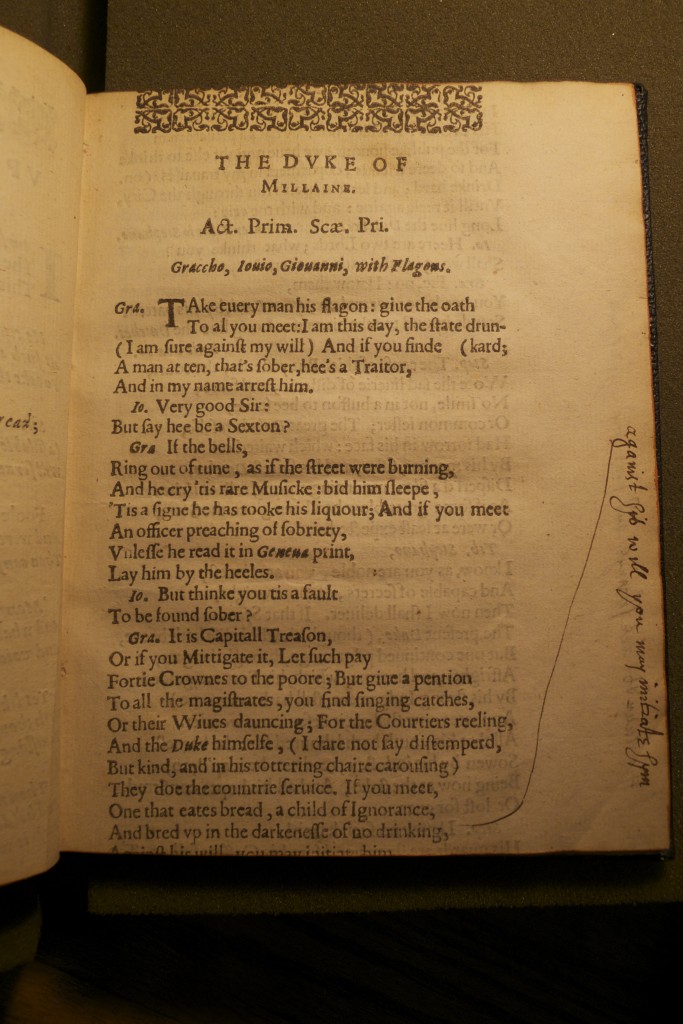

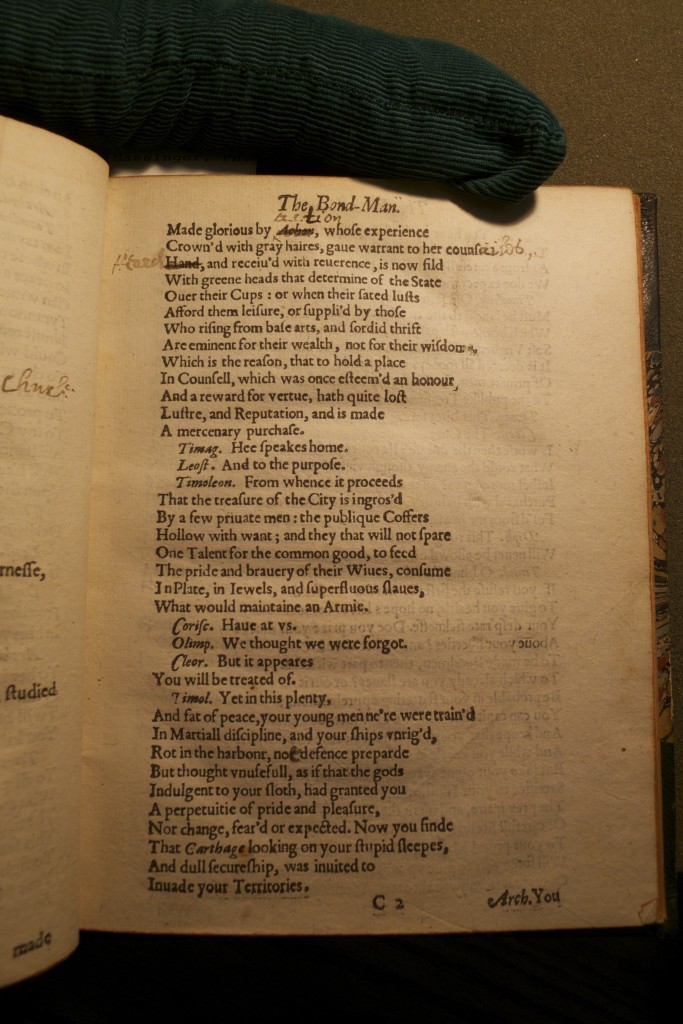
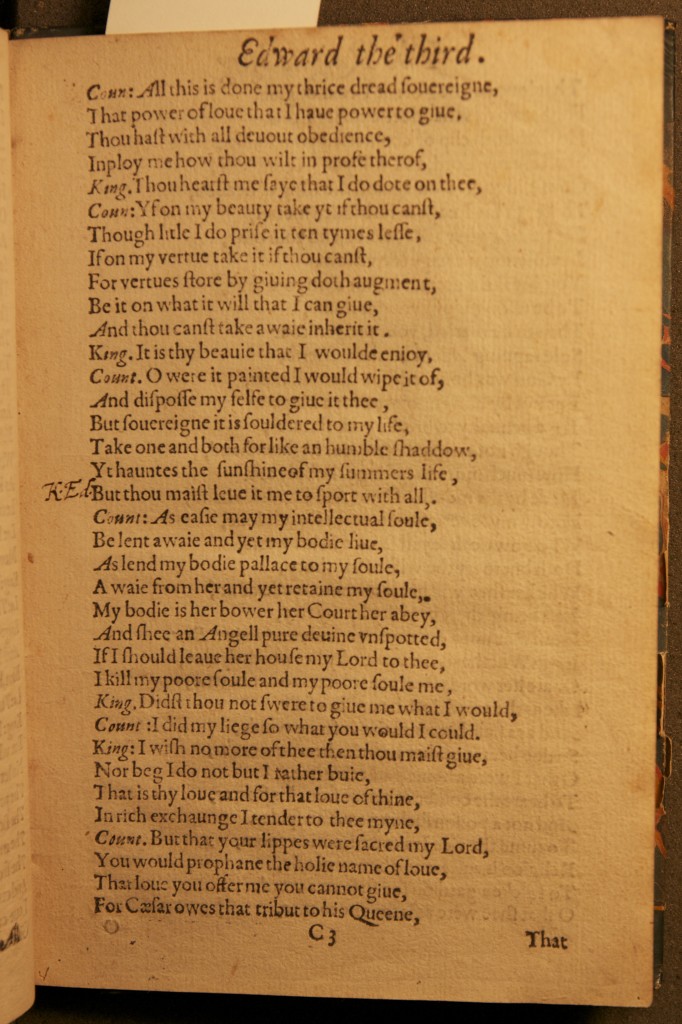

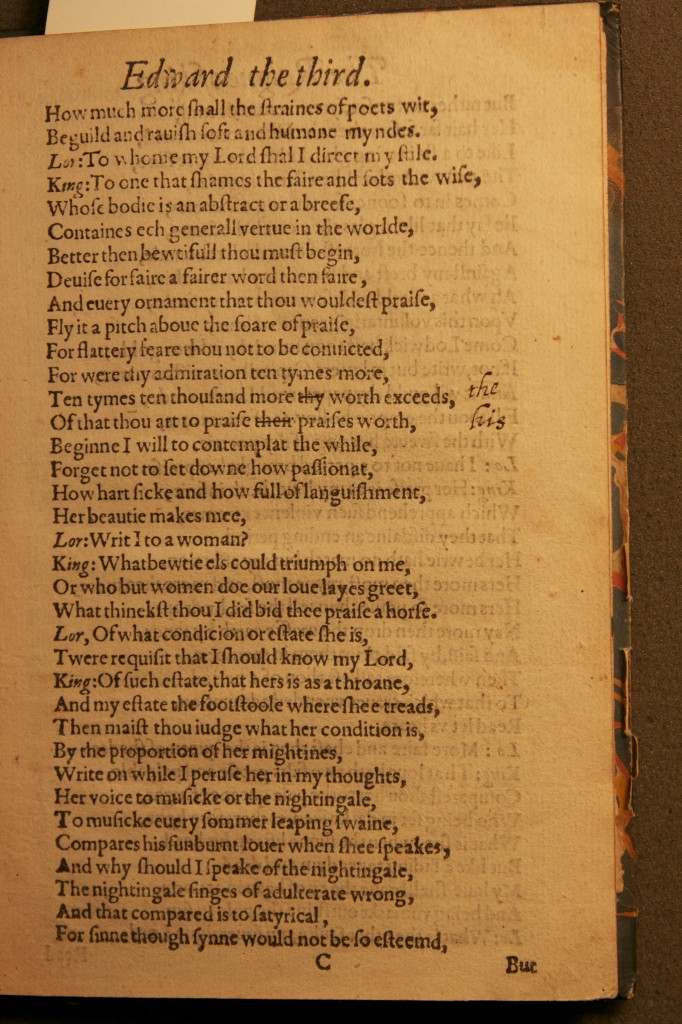

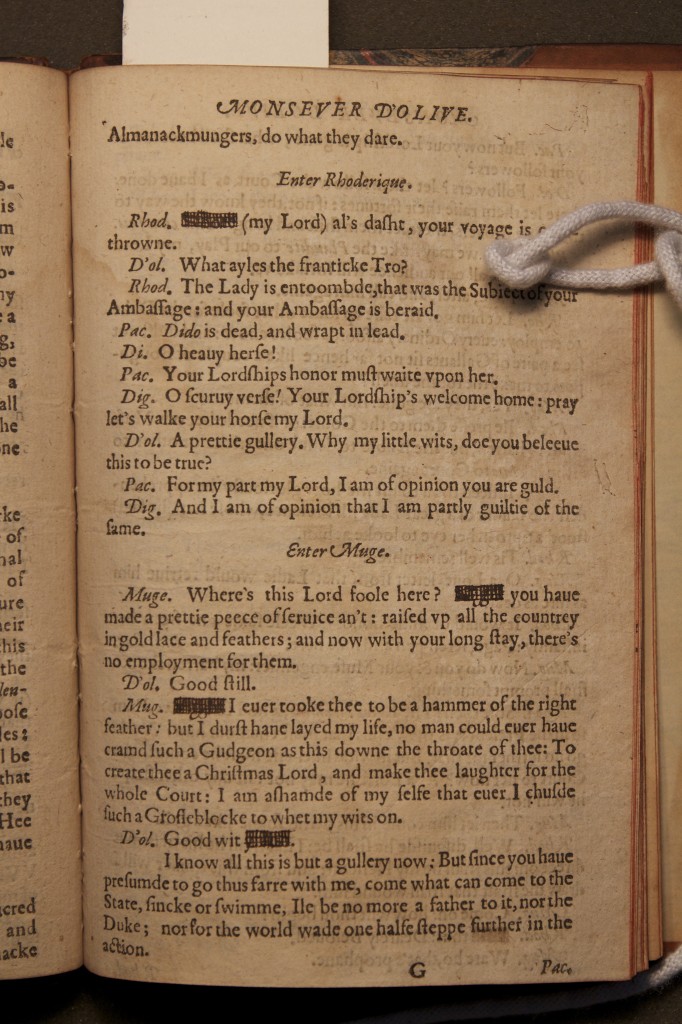
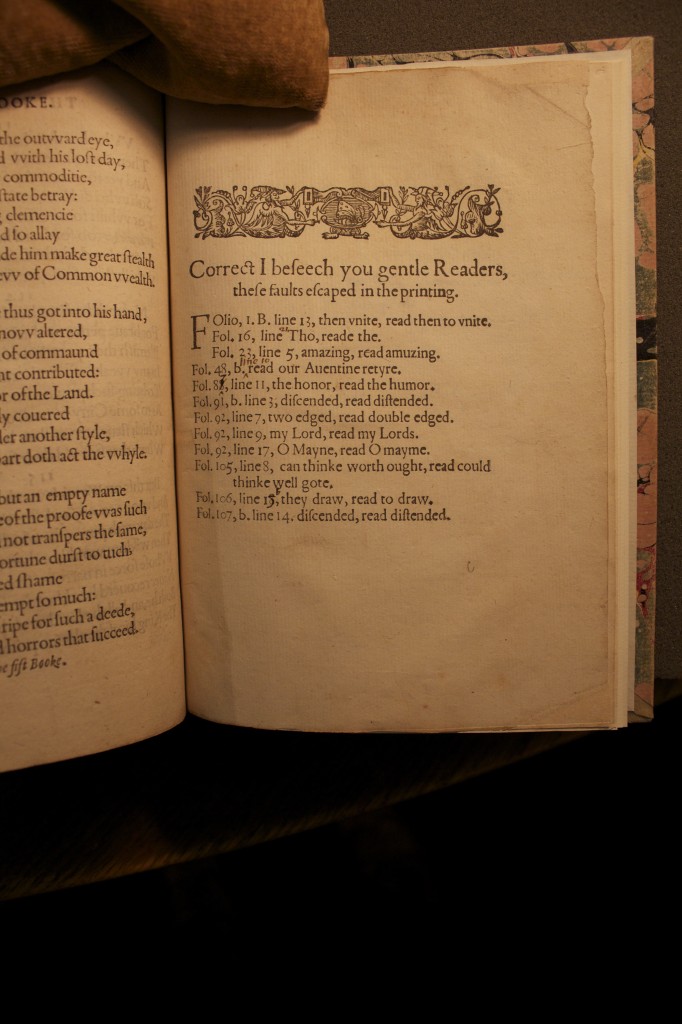

Just idle curiosity here, Holger, but I wondered: do the problems of cropping in the binding of these Massinger plays suggest that there was some sort of problem in the printing house? Do you think the paper might have occasionally been inexpertly placed on the press, so that the text was shifted down a bit from normal? As I say, just an idle question. Thanks for posting such fascinating images!
Interesting question, Andy, but I doubt it. It couldn’t have been a problem with the paper being put down improperly (since that would, at worst, only lead to the top or the bottom of the page being cut off, not both). I could imagine the page of type being fitted so poorly into the forme that it ran over at the top or the bottom — but that’s already a bit of a stretch, and I can’t see how any compositor would make such a mistake both at the top AND the bottom — and in both the inner and outer forme. I think it’s more likely that The Duke of Milan was printed on larger paper than some of the other quartos Massinger had bound together, and the binders had to damage the text to make the book fit into the volume. (This is reasonably easily checkable, but I, alas, have to go back to budget spreadsheets now….)
One more thing: apparently Greg suggested, in 1924, that Massinger was “working through the plays individually, making his corrections. When he reached the second act of The Picture he stopped and sent the quartos to be bound. When the bound volume came back, he found that The Duke of Milan had been cropped, and he wrote the two lines which had been damaged; but he did not return to the task of correcting, and the remainder of The Picture, The Fatal Dowry and The Maid of Honour are without any corrections” (Edward & Gibson, xxxii).
Yup. It’s in “More Massinger Corrections,” which appeared in The Library in 1924 (and was reprinted in his Collected Papers in 1966). Just read it, and I think the hypothesis makes sense. But it opens up an intriguing related question: if this is Massinger putting together a collection for a patron (which makes more sense to me than the scenario where the plays are being corrected for a reprint — if that were the case, why go to expense of binding them together?), then it seems to follow that heavily marked up texts, even somewhat messily marked up texts, were perfectly acceptable for such a purpose; the aesthetics of correctness trump the aesthetics of visual appeal.
Edward and Gibson suggest, in the general introduction to their _Plays and Poems of Philip Massinger_, that Massinger was putting together a collection of plays for presentation to a patron (xxxiii). He may also have been thinking about using them for a collected edition, since he was pretty active in the correction and publication of his own plays. So yes, the corrections are specifically designed to clarify and explicate the text for a reader, either a single patron or a new printer. But it suggests, too, that he either didn’t have manuscript copies of all the plays, or maybe that it was just easier to correct a spotty printed copy and send it off to a second printer, rather than starting from scratch making a clean copy…